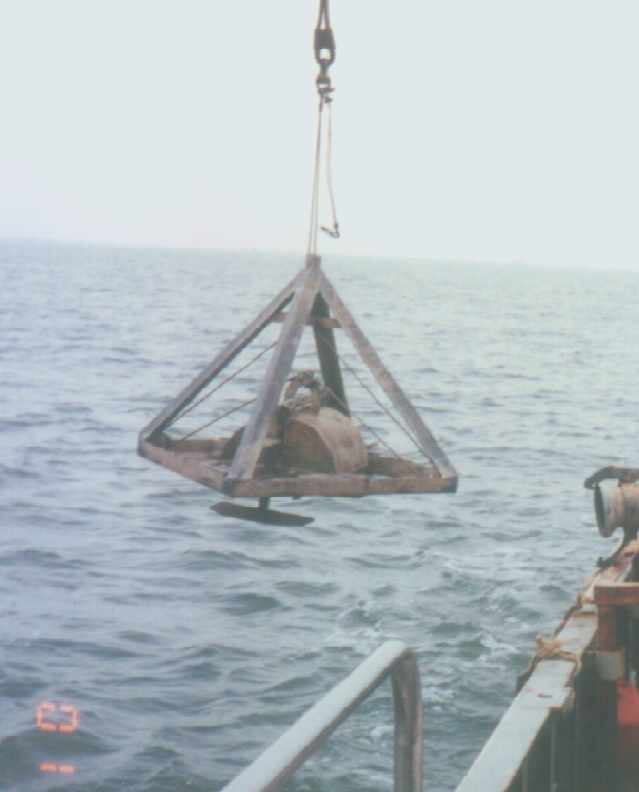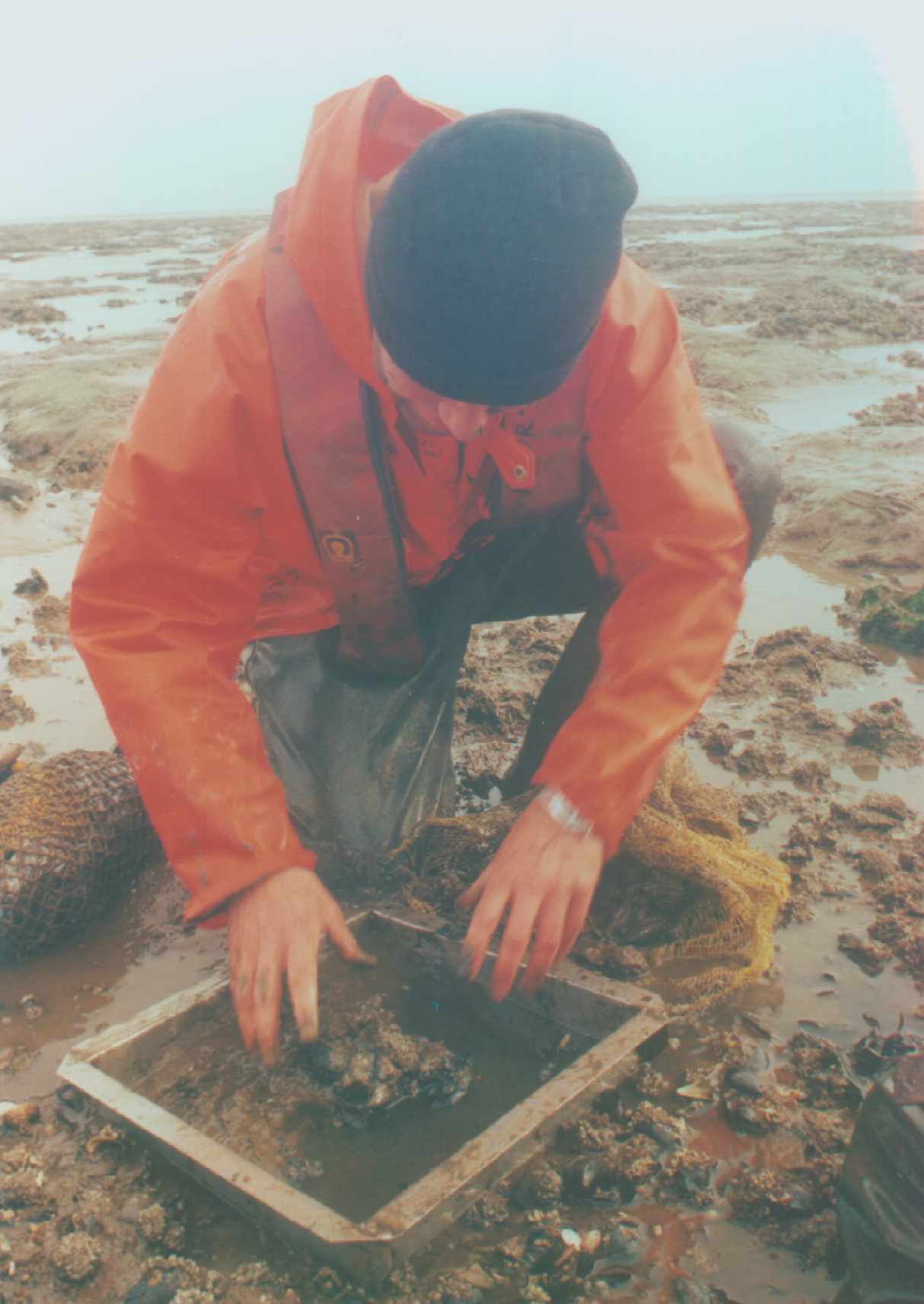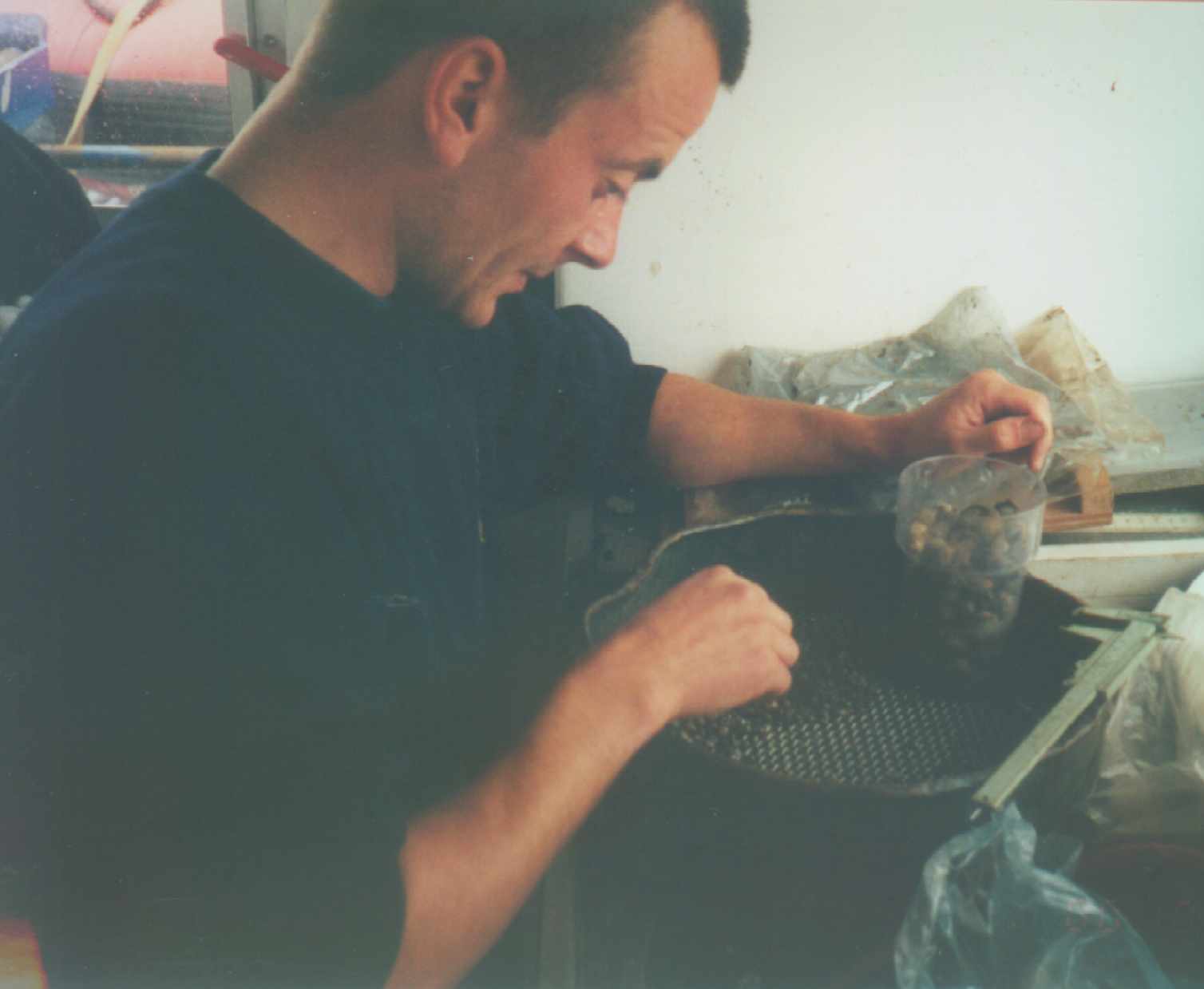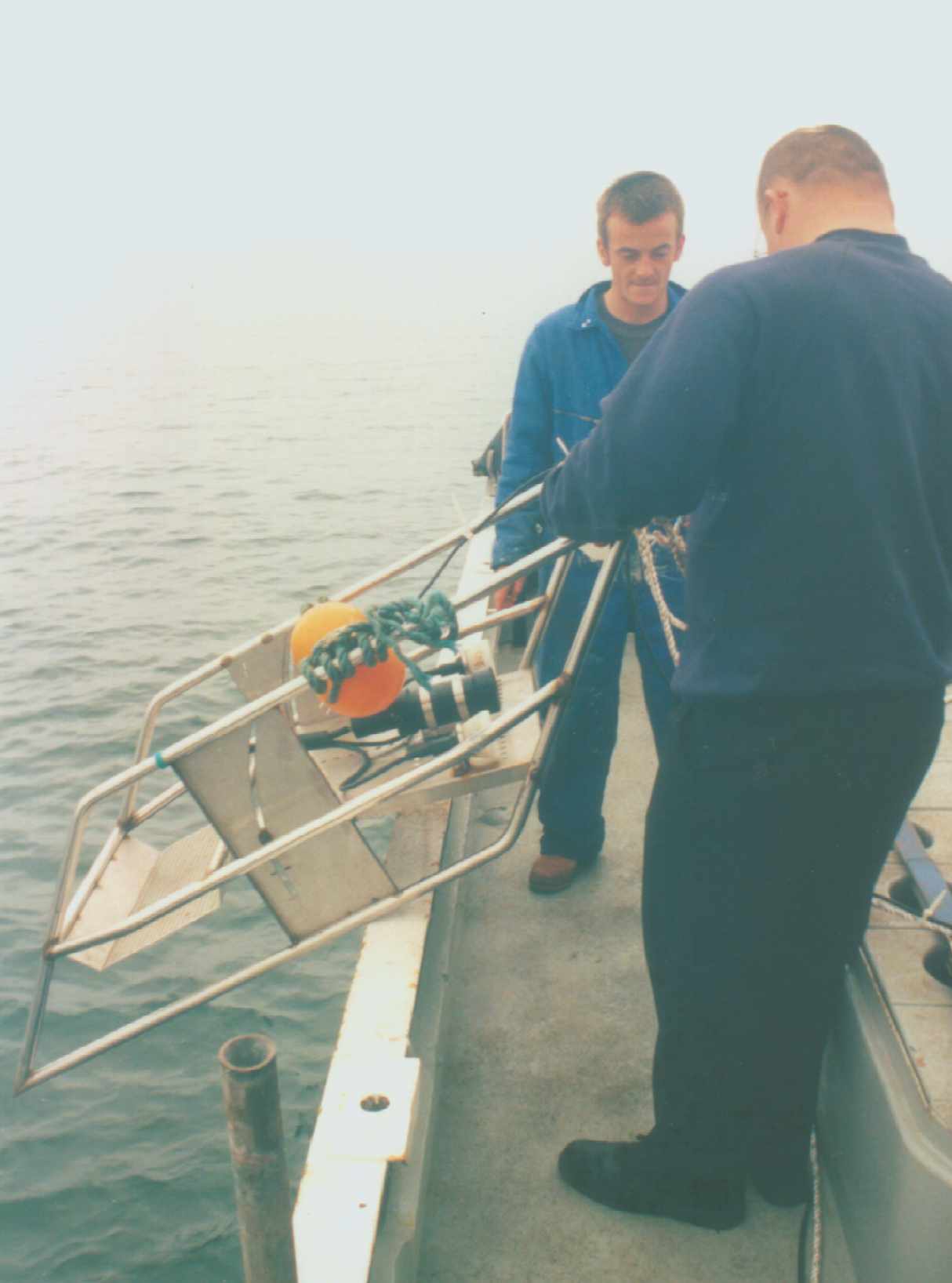Research
In order to be able to successfully manage a fishery it is important to have a good understanding of what stocks are available. To achieve this understanding the Committee has a dedicated research vessel, ESF Three Counties, and a staff of Research Officers who regularly monitor the condition of the stocks within the district. Surveys conducted at sea provide the data that can then be analysed using computer software to create stock assessments.
Cockles and mussels are of great commercial value to the district’s
fishermen, particularly in the Wash, so a lot of effort is taken to accurately
assess the stocks of these two species. Twice a year surveys are conducted
on all of the known cockle beds, and annually each of the mussel beds are assessed. Cockle surveys are conducted either over
the high water periods utilising a Day grab from the research vessel, which
takes samples from the seabed at precise locations, or by sampling using quadrats
during foot surveys. 1,272 sample stations covering twenty sandbanks were
surveyed during the course of the 2008 spring cockle surveys, with every cockle
caught in these samples being measured, aged and weighed. The data gained
from these surveys is then analysed using MapInfo Geographical Information
software from which charts can be produced showing the areas and densities
of the stocks over these beds. The information gained from this work is then
used directly to facilitate the management of the cockle fishery. A second
series of cockle surveys are conducted between October and December to ascertain
what impact the previous fishery may have had on the stocks and to determine
the extent of any spatfall that may have occurred. In recent years additional
environmental data has also been collected from the cockle sample sites. This
has included collecting information about sediment types and the distribution
of lugworm (Arenicola marina), Sand Mason worm (Lanice conchilega)
and Baltic tellins (Macoma balthica).
of the mussel beds are assessed. Cockle surveys are conducted either over
the high water periods utilising a Day grab from the research vessel, which
takes samples from the seabed at precise locations, or by sampling using quadrats
during foot surveys. 1,272 sample stations covering twenty sandbanks were
surveyed during the course of the 2008 spring cockle surveys, with every cockle
caught in these samples being measured, aged and weighed. The data gained
from these surveys is then analysed using MapInfo Geographical Information
software from which charts can be produced showing the areas and densities
of the stocks over these beds. The information gained from this work is then
used directly to facilitate the management of the cockle fishery. A second
series of cockle surveys are conducted between October and December to ascertain
what impact the previous fishery may have had on the stocks and to determine
the extent of any spatfall that may have occurred. In recent years additional
environmental data has also been collected from the cockle sample sites. This
has included collecting information about sediment types and the distribution
of lugworm (Arenicola marina), Sand Mason worm (Lanice conchilega)
and Baltic tellins (Macoma balthica).
 Mussel
surveys are generally conducted
on foot at low water over a period of two months in Autumn, again the data
acquired from these surveys providing information that can be displayed on
charts and used to calculate stock levels. In addition to the work conducted
on intertidal beds, the research team also undertakes surveys to discover
new beds of sublittoral mussels. Unlike those found on intertidal beds, sublittoral
stocks do not dry out at low water and are, therefore, harder to find. In
recent years the research team has been able to use RoxAnn Acoustic Ground
Discrimination System (AGDS) technology to help in this search. RoxAnn analyses
the returning echo from the vessel’s echo sounder, and by breaking it
down into two values representing the hardness and the roughness of the ground,
can be used to graphically illustrate the seabed features. When used in conjunction
with Microplot computer software, this information can be displayed instantly
as the vessel’s track. This is important because it enables features
like mussel beds, which have a distinct RoxAnn signature, to be recognised
instantly without the need to undergo extensive reanalysis
later.
Mussel
surveys are generally conducted
on foot at low water over a period of two months in Autumn, again the data
acquired from these surveys providing information that can be displayed on
charts and used to calculate stock levels. In addition to the work conducted
on intertidal beds, the research team also undertakes surveys to discover
new beds of sublittoral mussels. Unlike those found on intertidal beds, sublittoral
stocks do not dry out at low water and are, therefore, harder to find. In
recent years the research team has been able to use RoxAnn Acoustic Ground
Discrimination System (AGDS) technology to help in this search. RoxAnn analyses
the returning echo from the vessel’s echo sounder, and by breaking it
down into two values representing the hardness and the roughness of the ground,
can be used to graphically illustrate the seabed features. When used in conjunction
with Microplot computer software, this information can be displayed instantly
as the vessel’s track. This is important because it enables features
like mussel beds, which have a distinct RoxAnn signature, to be recognised
instantly without the need to undergo extensive reanalysis
later.
In addition to finding sublittoral mussels,
RoxAnn  can
also used to find other seabed features such as the
biogenic reefs formed by the Ross worm, Saballeria spinulosa. These fragile
reefs are an important feature of the marine environment and as such are an
interest feature of the Wash and North Norfolk Coast marine Special Area of
Conservation (SAC) and the Wash Site of Special Scientific Interest (SSSI).
As it is the Joint Committee’s responsibility to protect these features
from disturbance it is envisaged that a byelaw will soon be put into effect
that will protect these reefs from fishing activity. Over the past four years
the research team has conducted frequent AGDS surveys in an attempt to map
the distribution and coverage of these reefs, providing information to assist
the management process.
can
also used to find other seabed features such as the
biogenic reefs formed by the Ross worm, Saballeria spinulosa. These fragile
reefs are an important feature of the marine environment and as such are an
interest feature of the Wash and North Norfolk Coast marine Special Area of
Conservation (SAC) and the Wash Site of Special Scientific Interest (SSSI).
As it is the Joint Committee’s responsibility to protect these features
from disturbance it is envisaged that a byelaw will soon be put into effect
that will protect these reefs from fishing activity. Over the past four years
the research team has conducted frequent AGDS surveys in an attempt to map
the distribution and coverage of these reefs, providing information to assist
the management process.
Crabs and lobsters are also of great commercial value to the fishermen working in the district. Since 2004 a comprehensive program of surveys have been conducted in order to study these stocks. In addition to studying landing data, this work has involved frequent surveys at sea conducted aboard commercial fishing vessels. These surveys have allowed thousands of crabs and lobsters to be measured, and unlike landings data, has enabled a population distribution of under-sized individuals to be ascertained. Between 2004-2006 approximately 2,500 lobsters were tagged and released, allowing an insight into their growth and movement patterns to be determined from re-captured individuals.
In order to protect the sustainability of the crab and lobster stocks, the Committee has a byelaw preventing the removal of berried (egg-bearing) females from the district. Although berried females are easy to spot, some fishermen are known to scrub the eggs off berried individuals making detection difficult. In order to counter this problem, over the past three years the research team has developed a chemical test that can be used to detect when the eggs have been scrubbed off such individuals. After thoroughly testing the technique over a two-year period, the test led to a successful conviction in 2007 in which a fisherman was found guilty of scrubbing fifteen berried lobsters.
 Although
the majority of the work conducted by the research team involves monitoring
of stocks, original research work is also conducted. Following the introduction
of hydraulic suction dredges to the cockle fishery in 1987 there have been
concerns about the survival rates of discarded individuals. Over the past
decade the research staff have closely monitored the discard breakage rates
and have conducted experiments to determine the mortality rates of discarded
individuals. Through this work it has been possible to determine the additional
incidental mortality that the dredge fishery can incur, and thus best advise
the managers on which beds are best opened or left closed.
Although
the majority of the work conducted by the research team involves monitoring
of stocks, original research work is also conducted. Following the introduction
of hydraulic suction dredges to the cockle fishery in 1987 there have been
concerns about the survival rates of discarded individuals. Over the past
decade the research staff have closely monitored the discard breakage rates
and have conducted experiments to determine the mortality rates of discarded
individuals. Through this work it has been possible to determine the additional
incidental mortality that the dredge fishery can incur, and thus best advise
the managers on which beds are best opened or left closed.
In addition to our own core monitoring and research work, the Committee also assists other scientific organisations conduct their work in the area. Over the years this has included assisting Newcastle University (on behalf of English Nature) to conduct broadscale seabed mapping, CEFAS to conduct annual razorclam surveys and the Centre For Ecology and Hydrology to conduct bird counts and invertebrate surveys. Water and biological samples are also collected every month for the Environmental Health Organisation so that the water quality can be monitored.
.
.